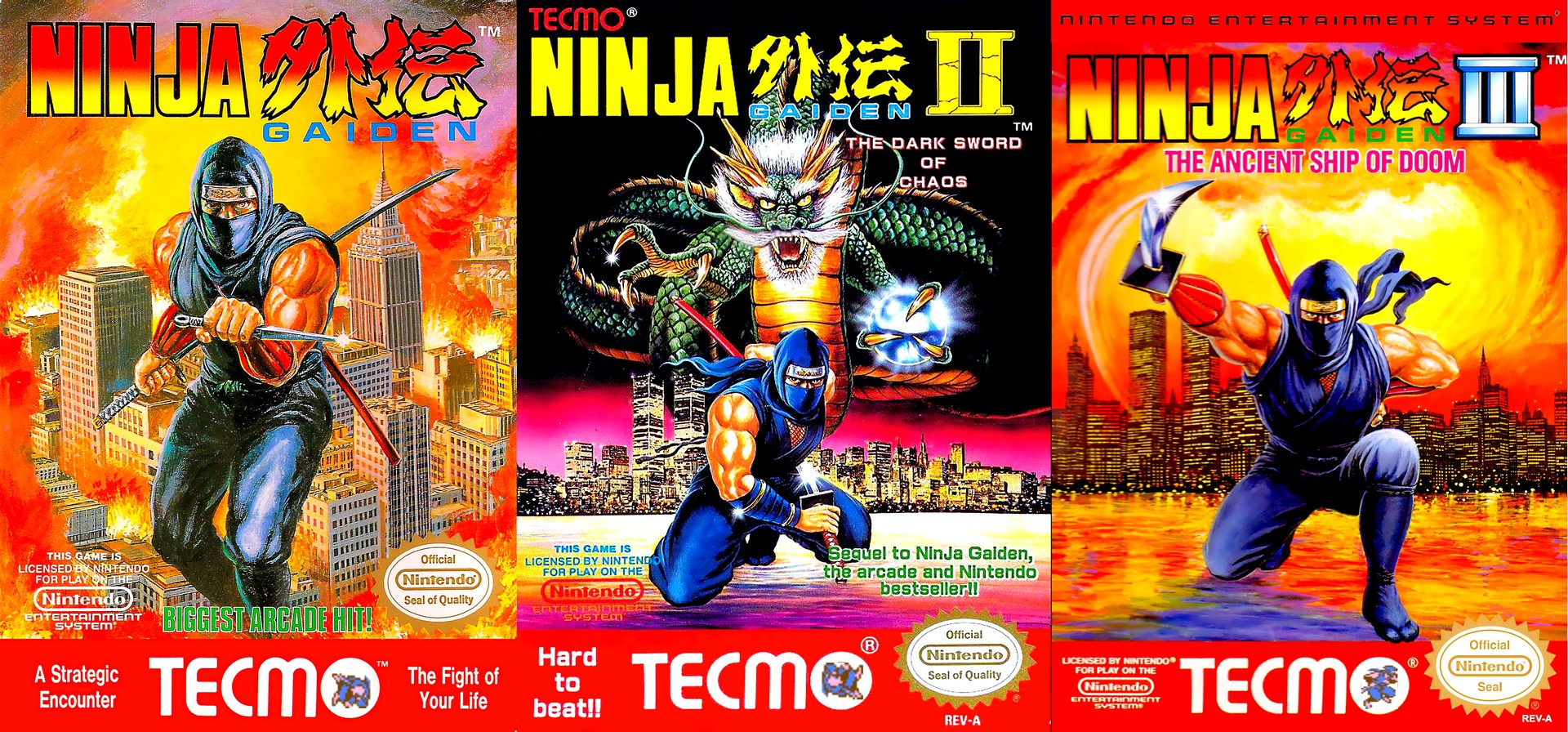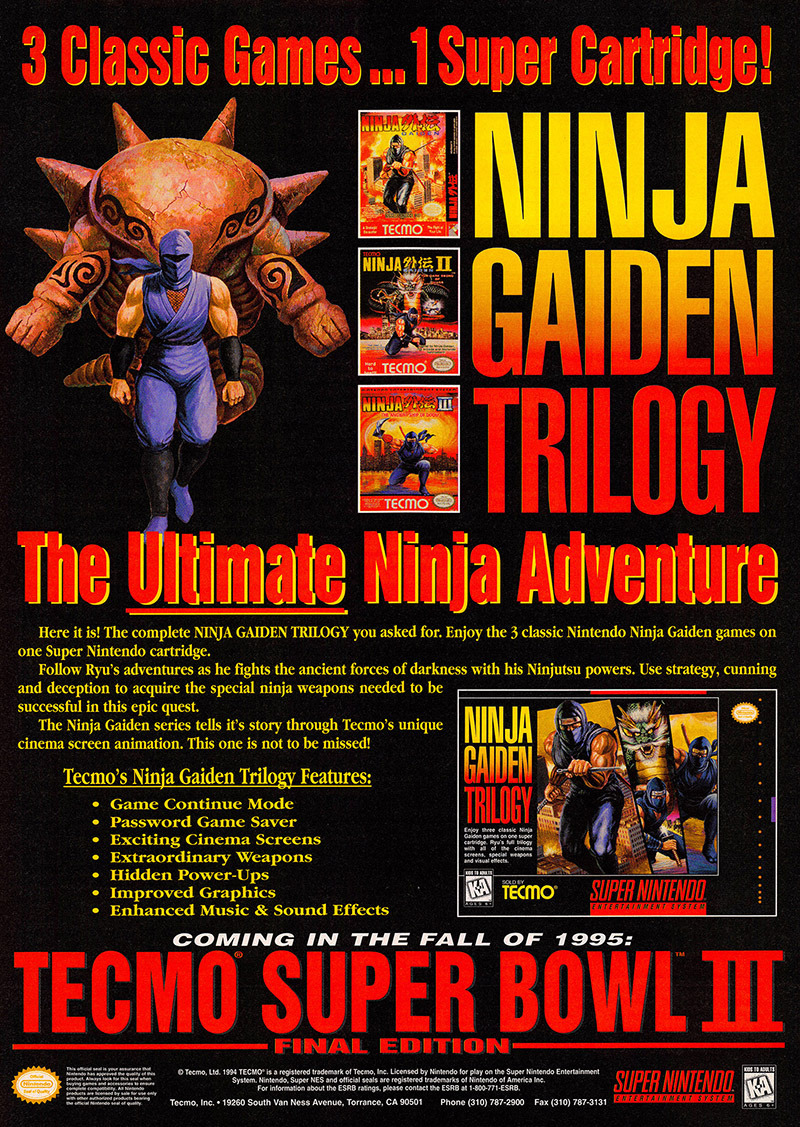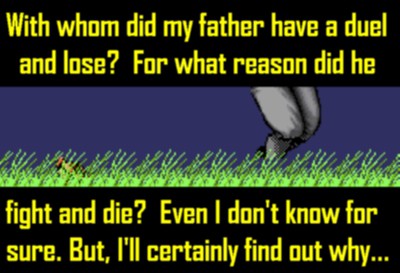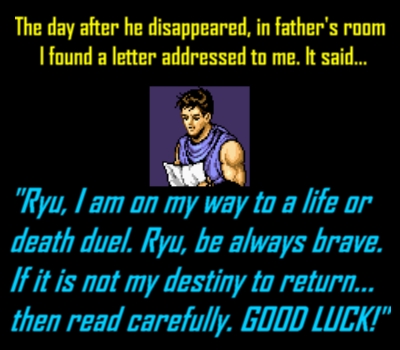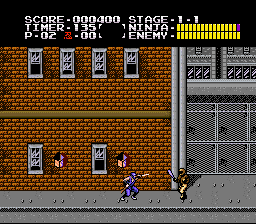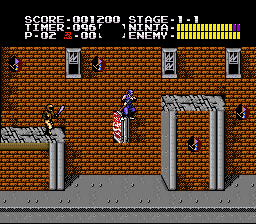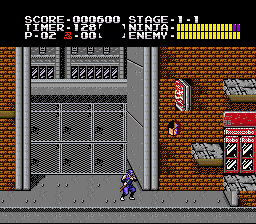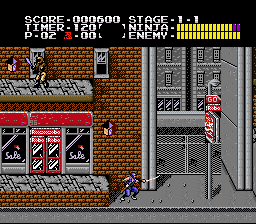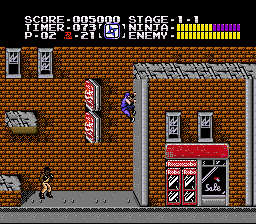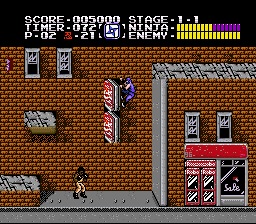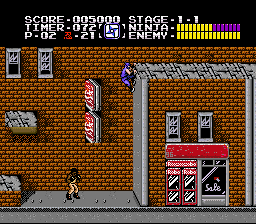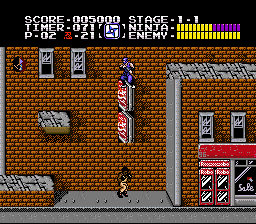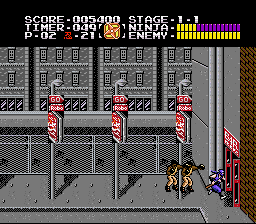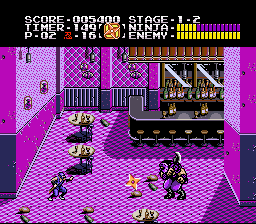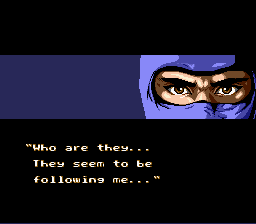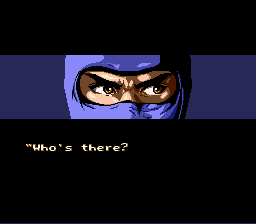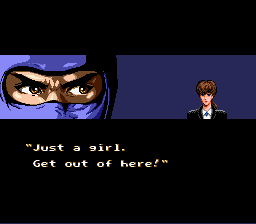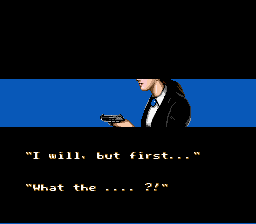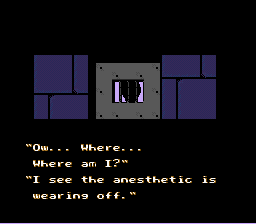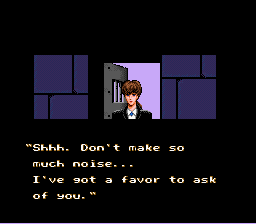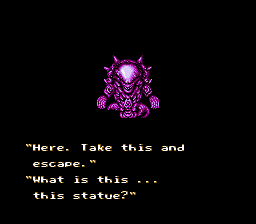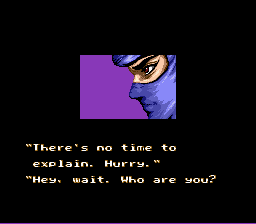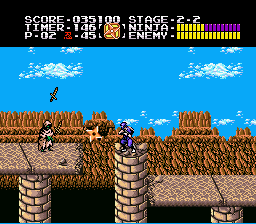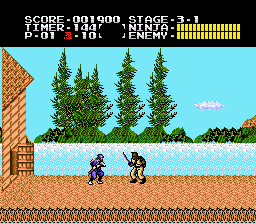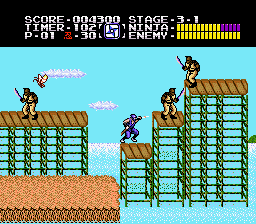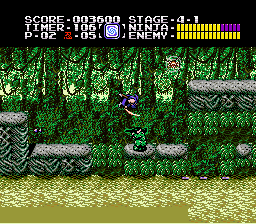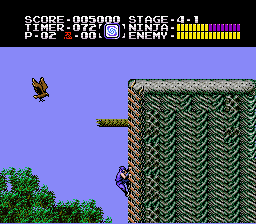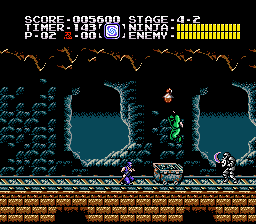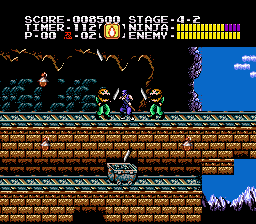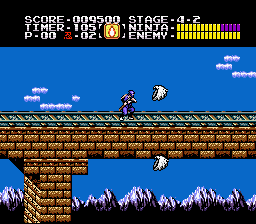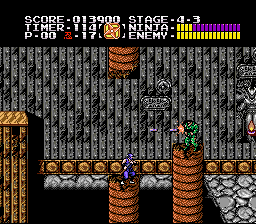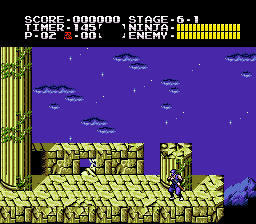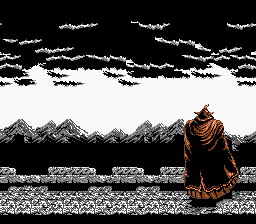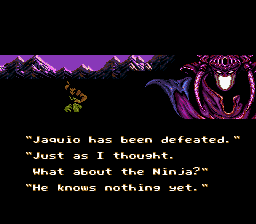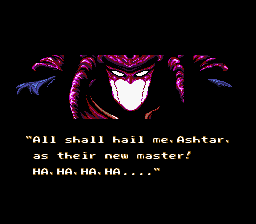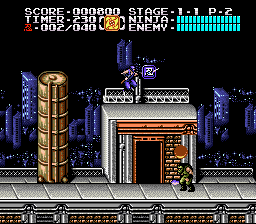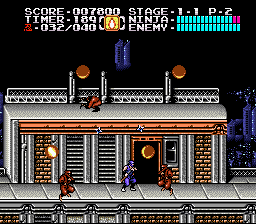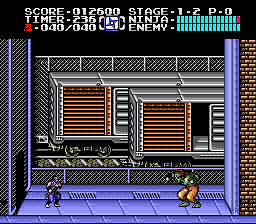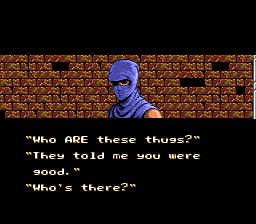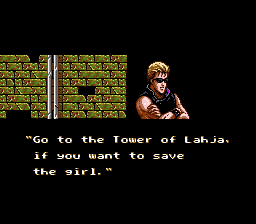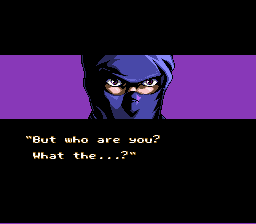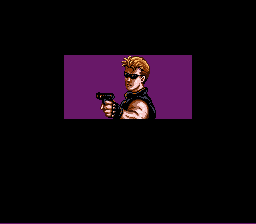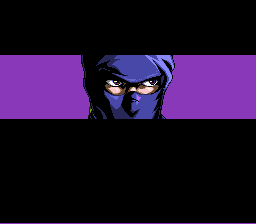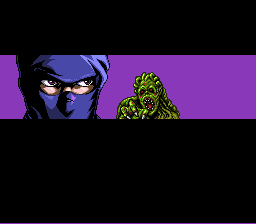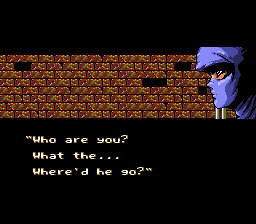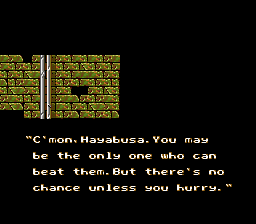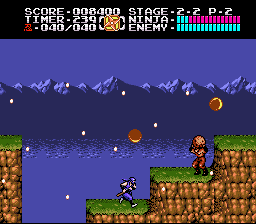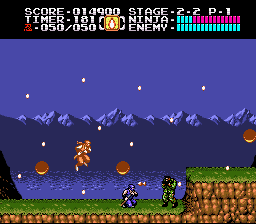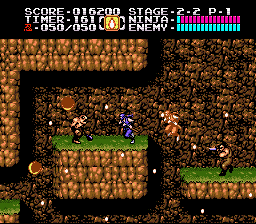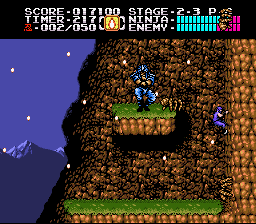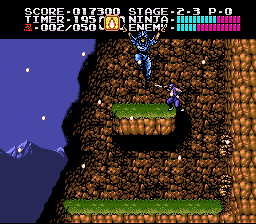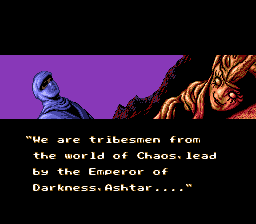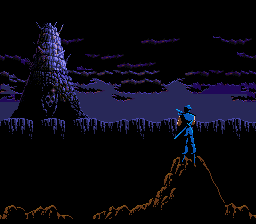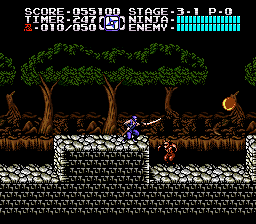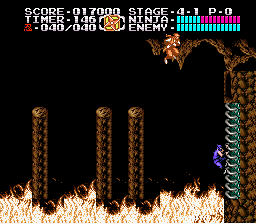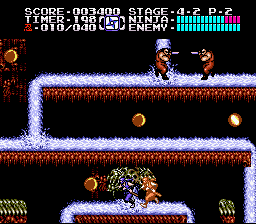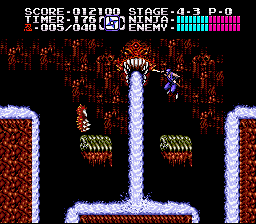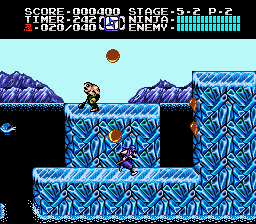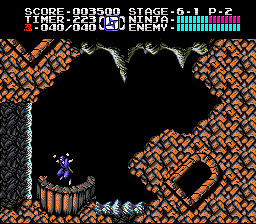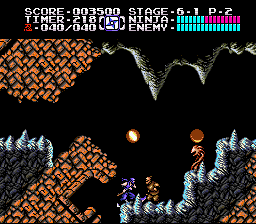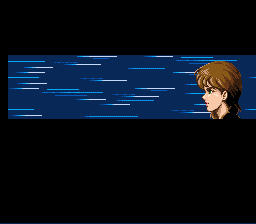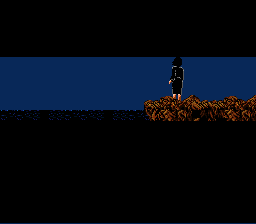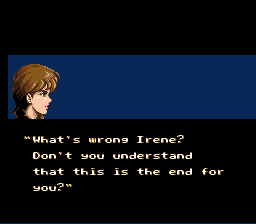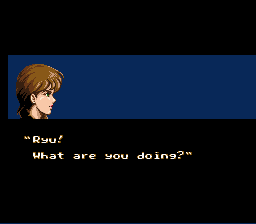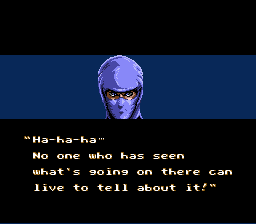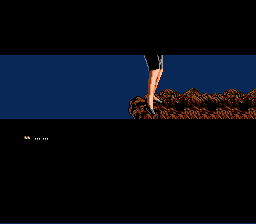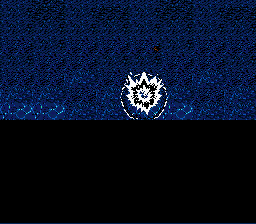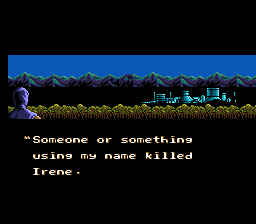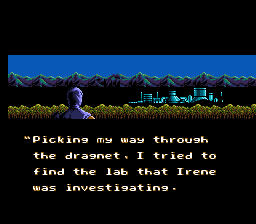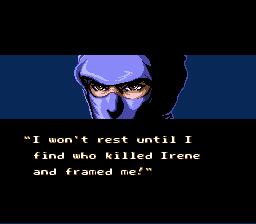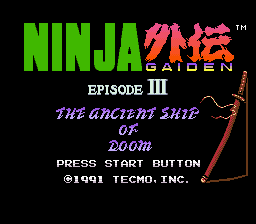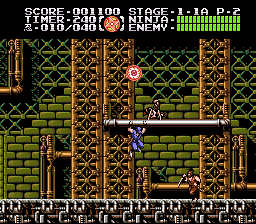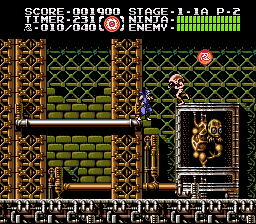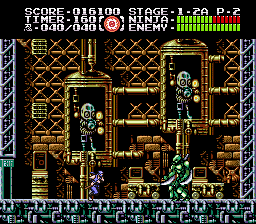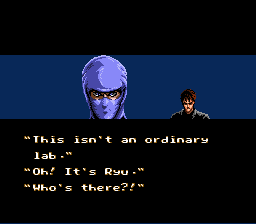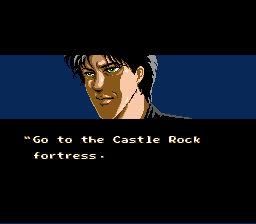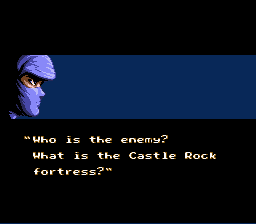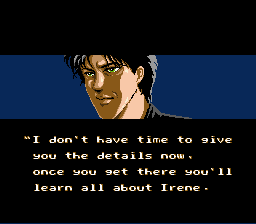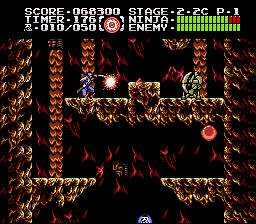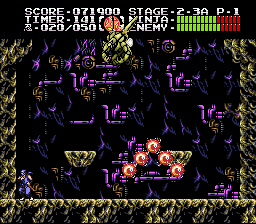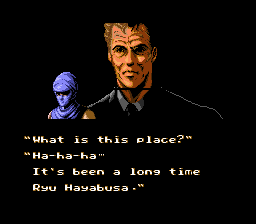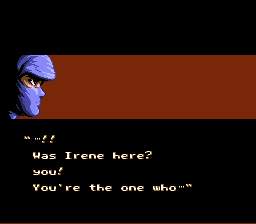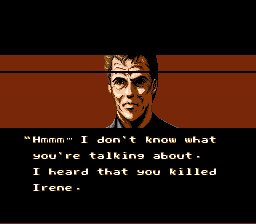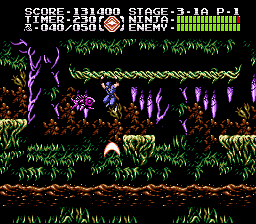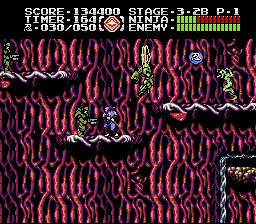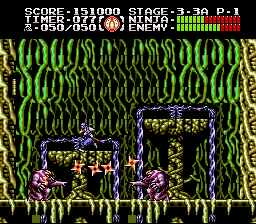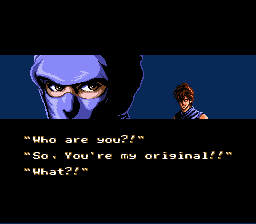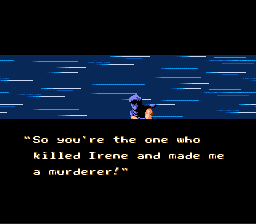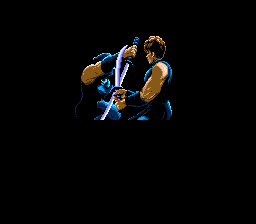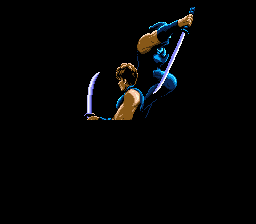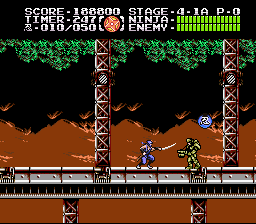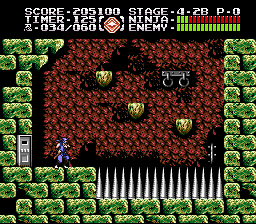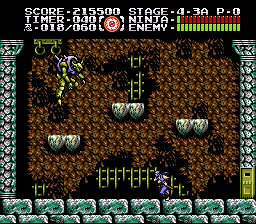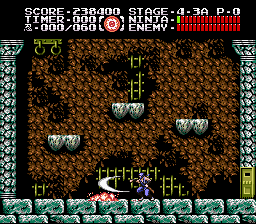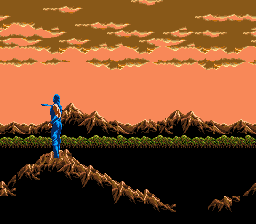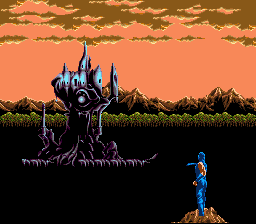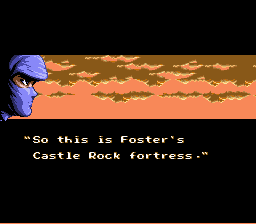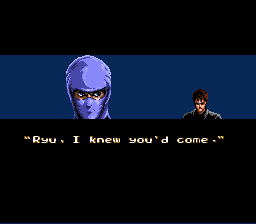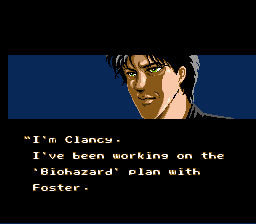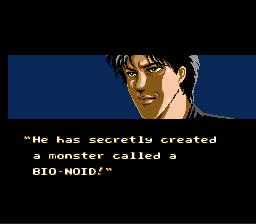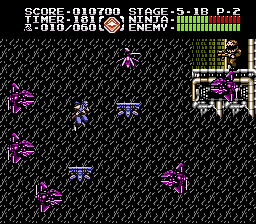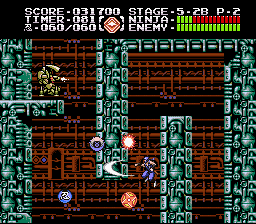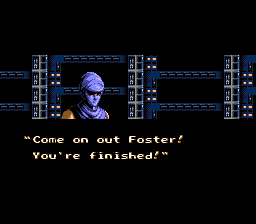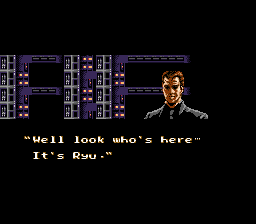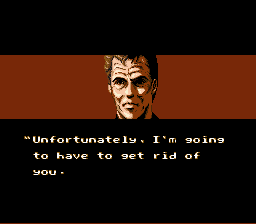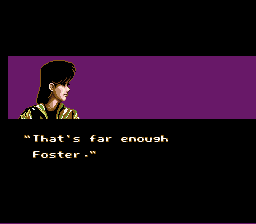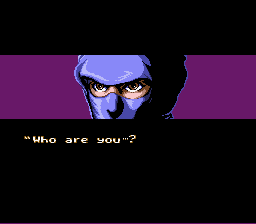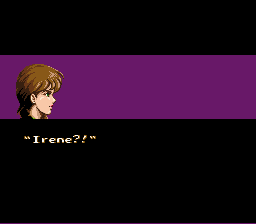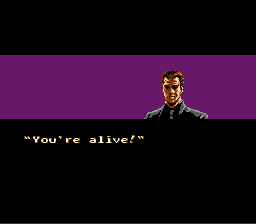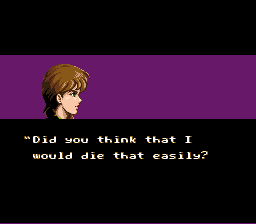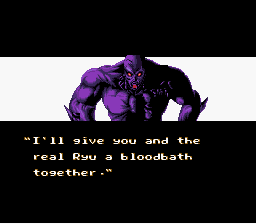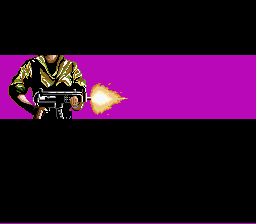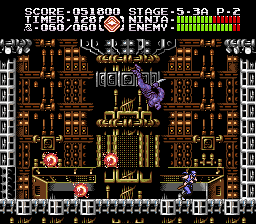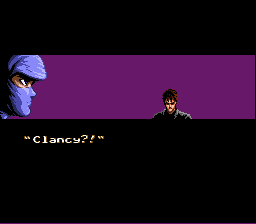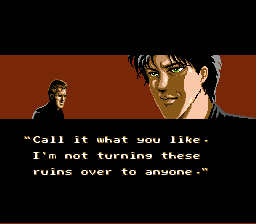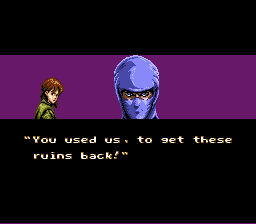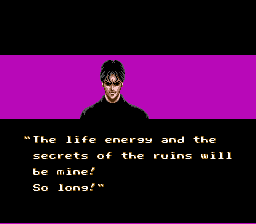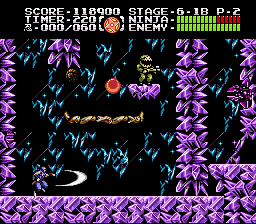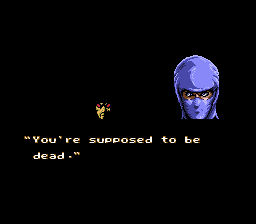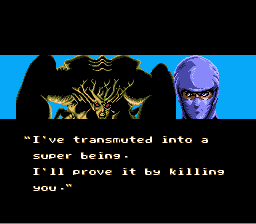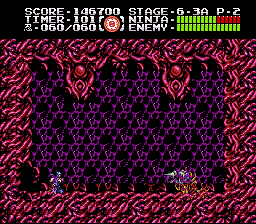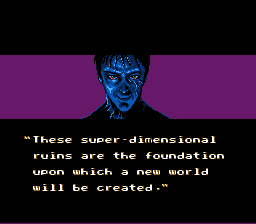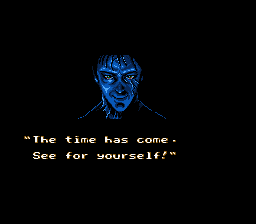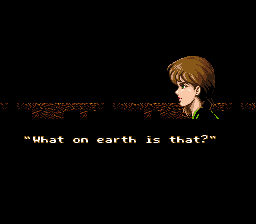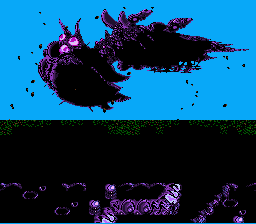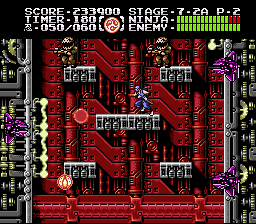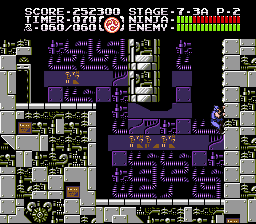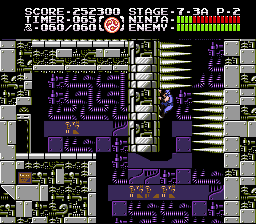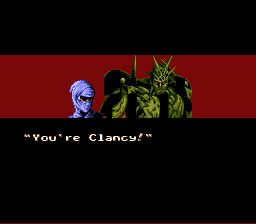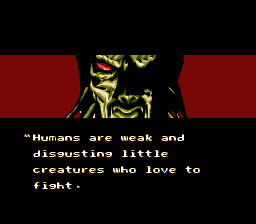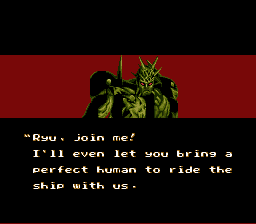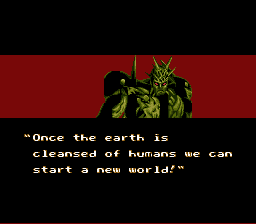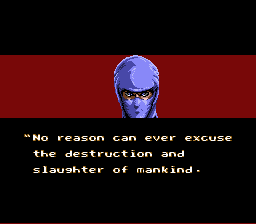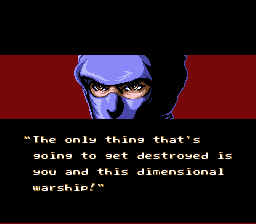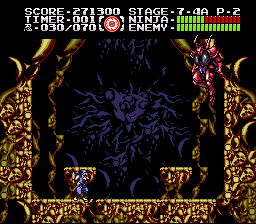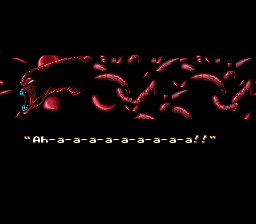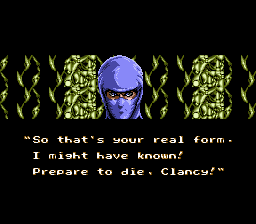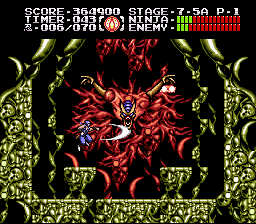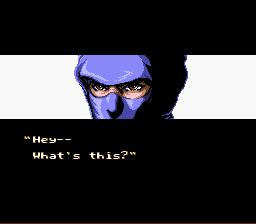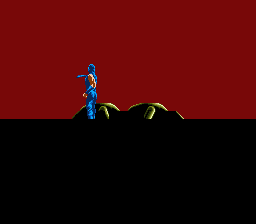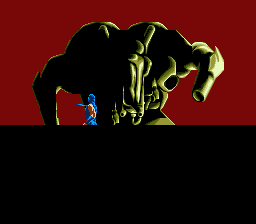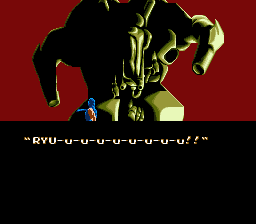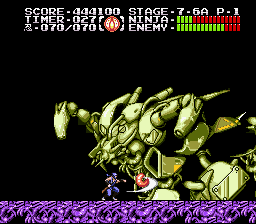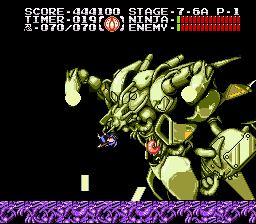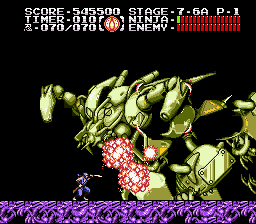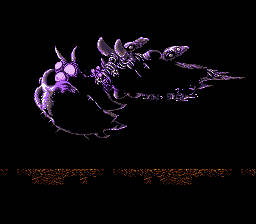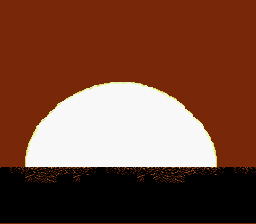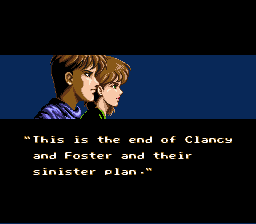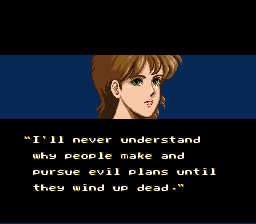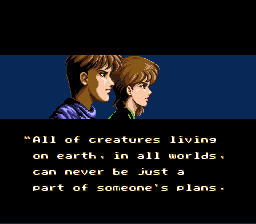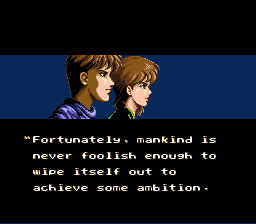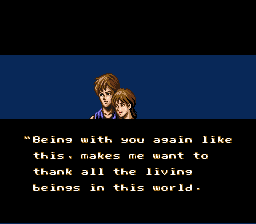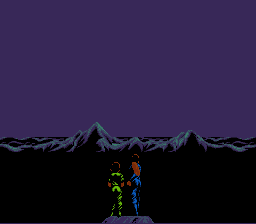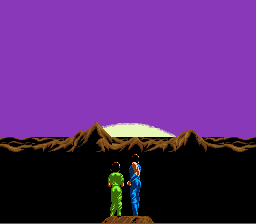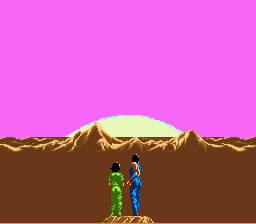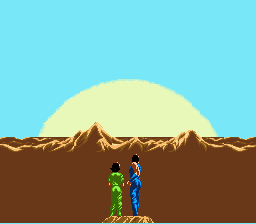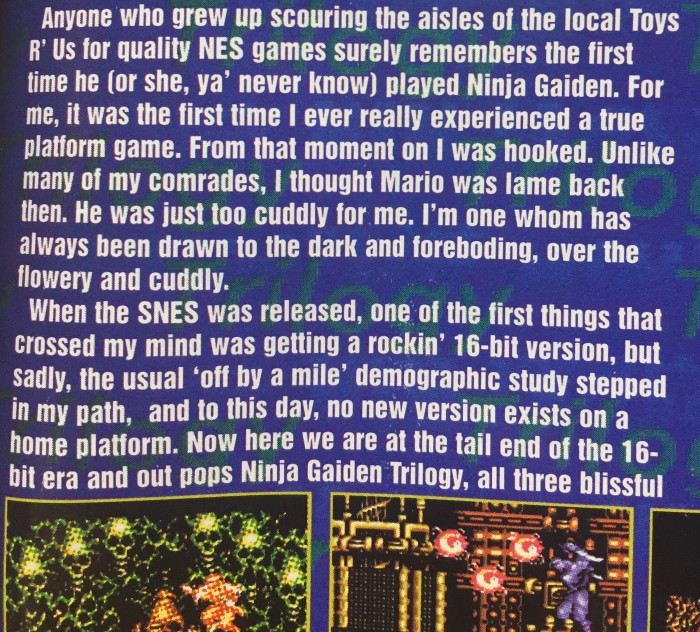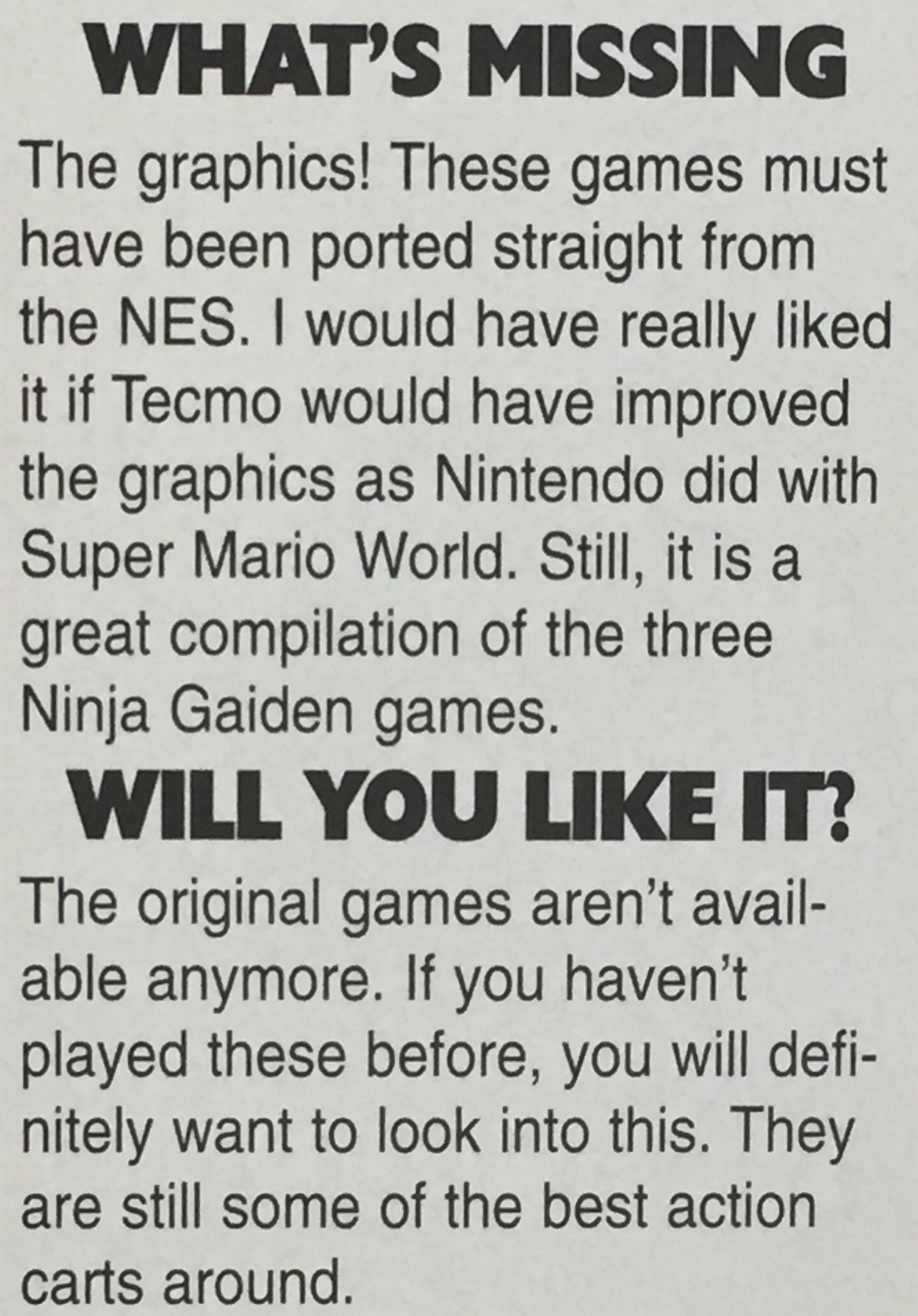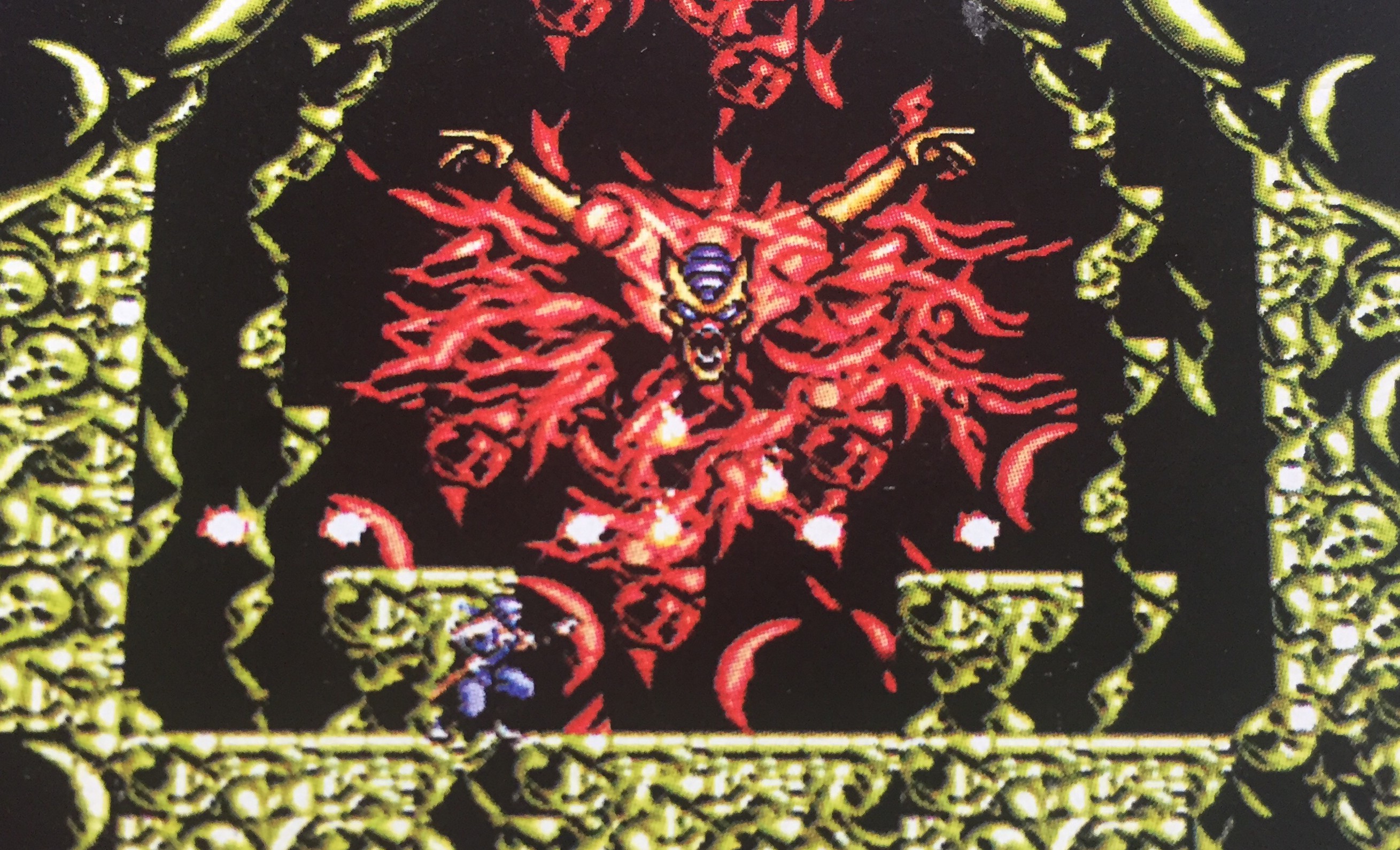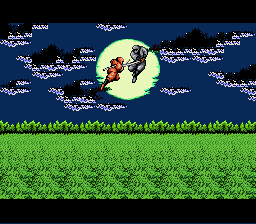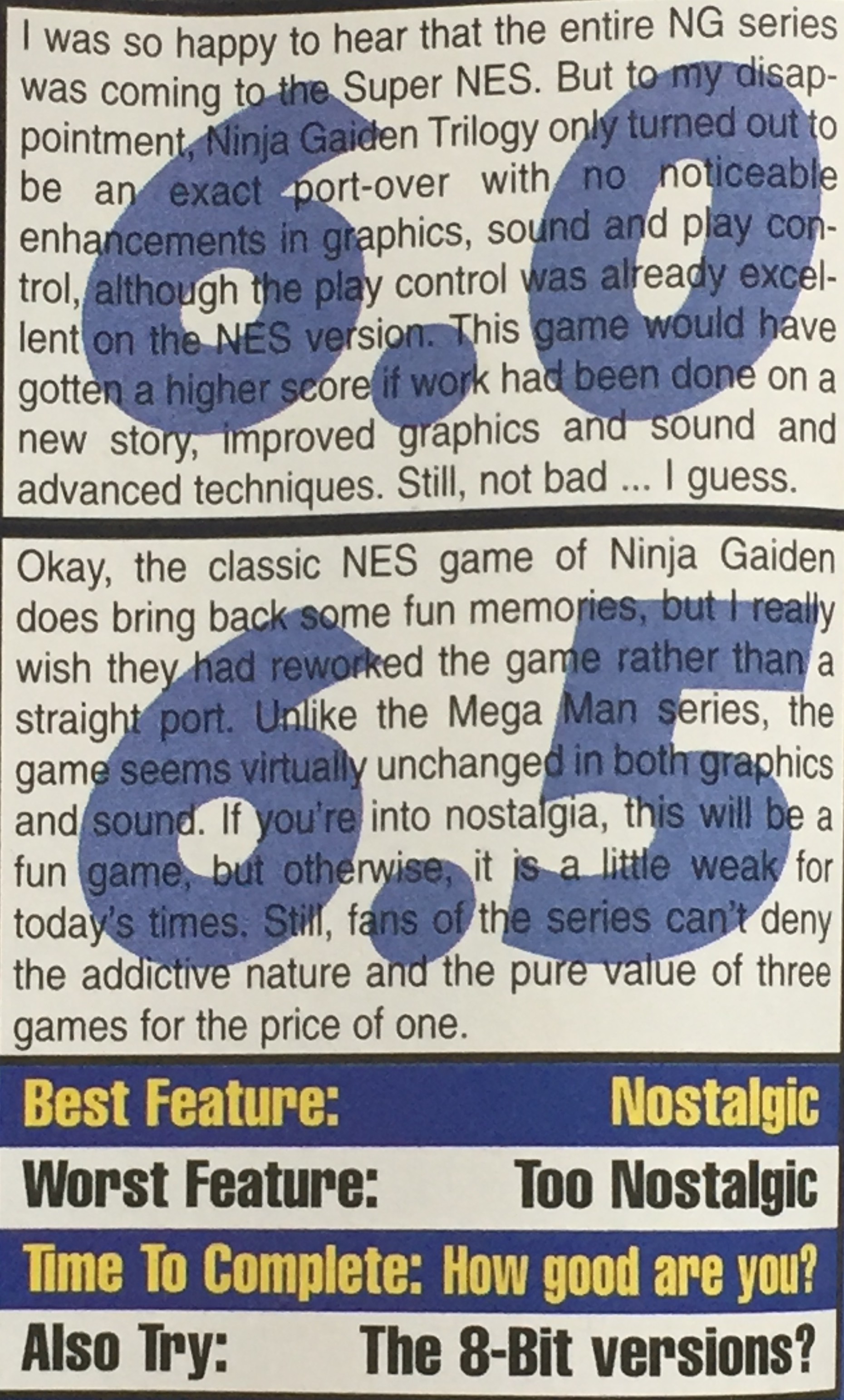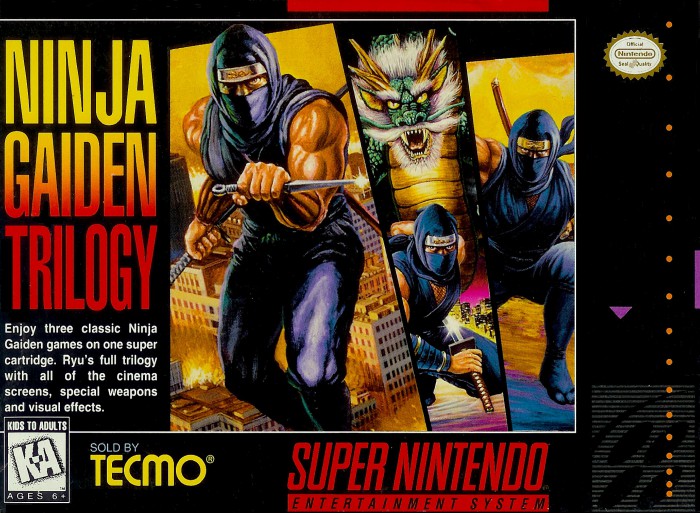
Ninja Gaiden originated in the arcades in 1988. It was a beat ‘em up akin to Double Dragon and it wasn’t too well received. The NES version came out later that same year and did a complete 180. Not only was it now a side-scrolling action platformer, but it was heralded at the time for being one of the best games in the entire 8-bit NES catalog. Two sequels were released on the NES in 1990 and 1991. When word of a Super Nintendo system surfaced in the early ’90s, NES fans worldwide began dreaming of their favorite 8-bit titles receiving a glorious 16-bit makeover. Castlevania, Contra, Mega Man, Metroid and so forth. Those games all received the SNES treatment while others were sadly left in the dust. The list of illustrious games snubbed includes Bionic Commando, Metal Gear, Rygar, and of course, Ninja Gaiden. But never fear, not all hope was lost. In the late summer of 1995, Tecmo gave SNES fans Ninja Gaiden Trilogy. Although not a proper 16-bit sequel, it gave us the three classic Ninja Gaiden NES hits on one cartridge, along with a brand new password feature. What could go wrong, right?
NINJA FEVER
The 1980s was the decade of excess. Ronald Reagan, Boy George, Milli Vanilli, and oh yeah, Ninjas R Us. Be it Teenage Mutant Ninja Turtles or Shinobi, ninjas dominated the scene. Cartoons, movies, toys and video games were inundated with ninjas galore. I remember my gaming group raving about Ninja Gaiden in the late ’80s. It was definitely a cut above your average NES game. We rented it a handful of times and could never beat it. The Ninja Gaiden games are notorious for their insane difficulty. While Ninja Gaiden wasn’t my absolute favorite, I always wanted to see a souped up 16-bit sequel — a Super Ninja Gaiden, if you will. Sadly, it wasn’t meant to be. But hey, at least Tecmo gave us Ninja Gaiden Trilogy. But it wasn’t without some controversy…
Diehard fans of the NES trilogy have picked apart Ninja Gaiden Trilogy over the years, claiming that the NES originals are superior. But for me, the greatest tragedy is that by the time Tecmo released this game, I was starting to lose interest in SNES and gaming itself. Back in August of 1995, I was worried as hell about the first day of junior high, and it became harder and harder to enjoy video games with the same kind of zest as when you were a little kid. It was a time of change in my life, and the SNES and gaming in general began taking more of a backseat. If only Ninja Gaiden Trilogy came out in 1992 or 1993, and then we got Super Ninja Gaiden in 1994. Alas, it wasn’t meant to be.
Fast forward to early 2006. I experienced an epic SNES renaissance. It was a golden time as most people had yet to hop on the SNES bandwagon of nostalgia. I beat the crowd by a good couple years. Life is all about timing, right? It wasn’t long before I snatched up Ninja Gaiden Trilogy. More than a decade later, I was finally going to play it. Speaking of decade, fun fact: these screenshots you see in this review were taken just over 10 years ago in May of 2008. I’ve been meaning to write a review of this game for ages…
NINJA GAIDEN
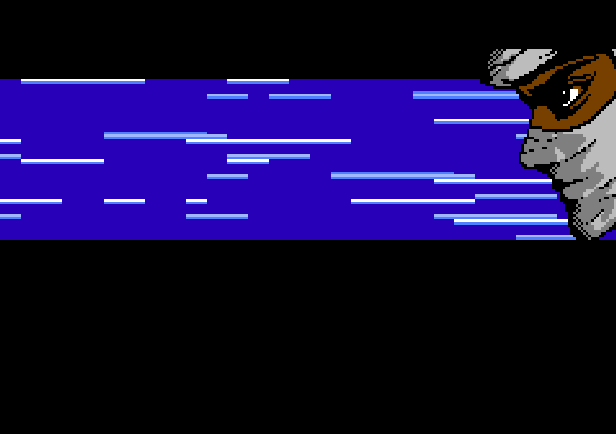

There’s something special about the first level in great games. Who could forget this classic first stage from Ninja Gaiden? Strike down bat wielding goons and use your deft ninja abilities to navigate your way through.
Graphics were advertised as being improved to the NES versions. While this may be true technically, the difference is disappointingly minimal. Don’t expect the kind of visual improvement as seen in Super Mario All-Stars. Tecmo could have beefed up the visuals but sadly they took the bare minimum route.
Remember hopping back and forth here in order to clear the top wall? Ah, that brings back the nostalgia…
Beware of those pesky boxers. Ah, who could forget the classic first boss fight in the bar? Good stuff.
Revered (in part) for its revolutionary cutscenes, Ninja Gaiden advanced its plot in a dramatic and memorable fashion.
Shooting someone (even if it’s an anesthetic) and then asking said victim to do you a favor? Whoever this lady is, she’s got BALLS. And a strange creepy looking statue that she wants you to have for whatever reason… that I’m sure is completely wholesome…
Similar to Castlevania, you can use various secondary attacks as long as you’ve collected enough ammunition. Long ranged attacks, such as the Shuriken, is a Godsend in such hairy situations.
Relaxing retreat on a timeshare this ain’t!
Secondary attacks range in effectiveness. It’s too bad you can’t collect them, switching off to the one you want as necessary. One of my favorites is the attack that allows you to jump and slash simultaneously, providing a sphere of precious protection around Ryu. It makes those unsettling platform jumps (i.e. the ones with a bad guy loitering at the edge) much more manageable.
Pumpkinhead rejects and various fiends greet you with foul intent.
Flying enemies — they’re the bane of many. Especially when your hero jumps back whenever hit. Machine gun toting mad men make your life a living hell. I hope you have an appropriate sub weapon!
Nintendo players back in the day were legit if they could beat Ninja Gaiden fair and square. It left its mark on many, and has certainly terrorized many a childhood in the best of ways.
NINJA GAIDEN II: THE DARK SWORD OF CHAOS
Thunder and lightning erupts over the land. Who’s the creepy guy in red?
Ashtar’s his name, and he’s looking to finish the job Jaquio could not from the first game.
Episode II: The Dark Sword of Chaos. Makes it feel epic like it’s from the Star Wars universe. One major improvement right off the bat is the ability to now climb walls. You had to hop back and forth in the first game but now you can scale various structures like a true ninja badass.
Visually, the game looks a lot better than its predecessor. Although I’m not a fan of the red button eyesores that serve as your sub weapon containers. The first game was a lot more creative, housing them in everything from flickering lights to even hummingbirds. But that’s just a minor gripe. The first boss is a generic mutant that loves to deliver shoulder tackles.
Innovative cutscenes helped made the original game so memorable, and Ninja Gaiden II kicks that up a notch.
Swerve City, USA! I had deja vu for a second there. Looked like poor ol’ Ryu Hayabusa was once again going to be subdued by some anesthetic but instead he’s saved by the bell bullet. I guess you owe Robert TS the favor after all.
Battling atop a boxcar train, you’ll have to fend off Jason Voorhees and friends. Watch the snow — the wind changes direction in three different ways. Jumping against the wind is a surefire ticket to an early demise.
Duplicate yourself and even up the odds a bit with your clone helper. Up to two clones can be used. Nice!
Arachnophobia? You won’t like this boss.
Another cool cutscene advances the plot and builds up the anticipation for the next level.
Disappointment (or relief, depending on one’s perspective) strikes in Stage 3-1. The original NES version had lightning flashes that made it more difficult and atmospheric, but for some strange reason, it was not duplicated in the SNES port. Many diehard fans have pointed out this omission over the years, citing it as the telltale sign of a lazy port job. Hey, at least we still get the ninja clones.
Hayabusa continues his quest, this time in some rather murky waters.
Things get a bit slippery here.
Hayabusa or Ashtar — who will prevail? Only you can decide that!
NINJA GAIDEN III: THE ANCIENT SHIP OF DOOM
Things open up blazing hot as Irene is seen being chased by… Ryu Hayabusa?! Wait, whaaaat?
Falling to her demise, can it truly be the same Ryu we all know and love? Surely not…
Framed — I knew it! [Sure ya did -Ed.].
Players have complained that the jumps in the third game are too floaty. It does take a while to get used to, especially if you’re hot off the heels of playing the first two games. Generally speaking, Ninja Gaiden III is considered to be the weakest entry in the trilogy. Not that it’s a bad game; it’s just the first two were so damn good.
There’s something about Ninja Gaiden III that I really like, though. The weird cybernetic atmosphere, for one. That and Ryu is a better climber here than he was in previous outings. I also like the extra long slash power up you can get. Able to hit enemies both high and low, it gives you excellent coverage for a short ranged attack.
Clancy tells you to head over to Castle Rock. You’re a little skeptical but you press on in the name of avenging Irene…
Quicksand has claimed many lives — move fast or you could be next! Better move fast too during the auto scrolling section. Death waits for no one!
Destroy enemy bullets with a well-timed strike. I love when games let you do that. The boss fits in perfectly with the game’s cybernetic theme.
Condescending? Check. Smug? Check. Good to see you again, Foster.
Acquiring the right power up at the right time is key. One of my favorites is the energy blast that goes up and down. It can prove to be quite useful.
Thankfully, the “jump back” when hit isn’t too bad in this game. Another reason why I like Ninja Gaiden III so much and don’t see it as the “black sheep” of the trilogy as some others do. The previous two games had some serious recoil action.
Hayabusa be like, “So… you’re Great Value Ryu, eh?”
Perhaps it’s just me but doesn’t Ninja Gaiden III have a slight Mega Man-esque look to it? Part of me almost expects to see some Mets flying in and out!
Nothing’s better than beating a boss with one measly life bar remaining. What a rush!
Overlooking Castle Rock, Ryu runs into Clancy once again. He tells you about a terrible monster named BIO-NOID. Coincidentally, the Biohazard plan Clancy has been working on is the same name as the Resident Evil franchise over in Japan. Clancy goes on to explain that there was an open seam between dimensions when the Demon died. Foster had rebuilt the fortress and was using it to conduct all sorts of transformation experiments with life energy. Bio-noids are super humans that have been transformed with life energy. He tells you that it was a Bio-noid that killed Irene and that you’re the only one strong enough to stop it.
Infuriatingly difficult platforming abounds. Thank God for the password feature.
Hayabusa confronts Foster but wait a minute — IRENE?!
Somehow, Irene survived after all. Screw you, Foster!
Remember the guy who framed Ryu? He turns into a super mutant only to be blasted by Irene. Show ‘im who’s boss!
Eventually you step in and tell Irene you got this. Now it’s you vs. the Creeper from Jeepers Creepers.
Spoiler… Clancy was the mastermind behind it all.
Explore more strange locales as you seek out to hunt down Clancy.
Hayabusa’s clone isn’t quite dead yet…
Shame this port wasn’t enhanced more visually. The SNES could do so much more with this background.
Unfortunately, you’re a bit too late. Clancy has already made the life energy his and rambles on about the dimensional warship’s power.
Thought the previous levels were hard enough? You ain’t seen nothing yet.
Precise and skilled platforming is the order of the day.
Genocide? Ryu ain’t down with that, Clancy. The time for talk is over.
Defending the fate of the universe, it’s up to you to put an end to this monster’s wicked plans.
Clancy’s true form is soon revealed…
Konami would be proud. Slash that sucker!
BLOODY HELL. You knew it couldn’t be that easy. Get ready for the final ultimate battle.
There’s screen-filling bosses and then there’s this guy. Holy shit. It doesn’t get any crazier than both life bars going down to the wire… with you barely winning out. On the final boss no less. Best feeling in a video game!
Sayonara, bitch!
Hayabusa dropping some knowledge there!
Regardless of how bad things may seem, never forget the darkest hour is just before the dawn.
REMEMBER WHEN…
I certainly was not alone. Many kids can fondly recall seeing Ninja Gaiden at Toys R Us back in 1989. We loved it even if it kicked our asses. Then when the SNES came out in 1991, we just assumed the inevitability of a souped up 16-bit version. Alas, it wasn’t meant to be.
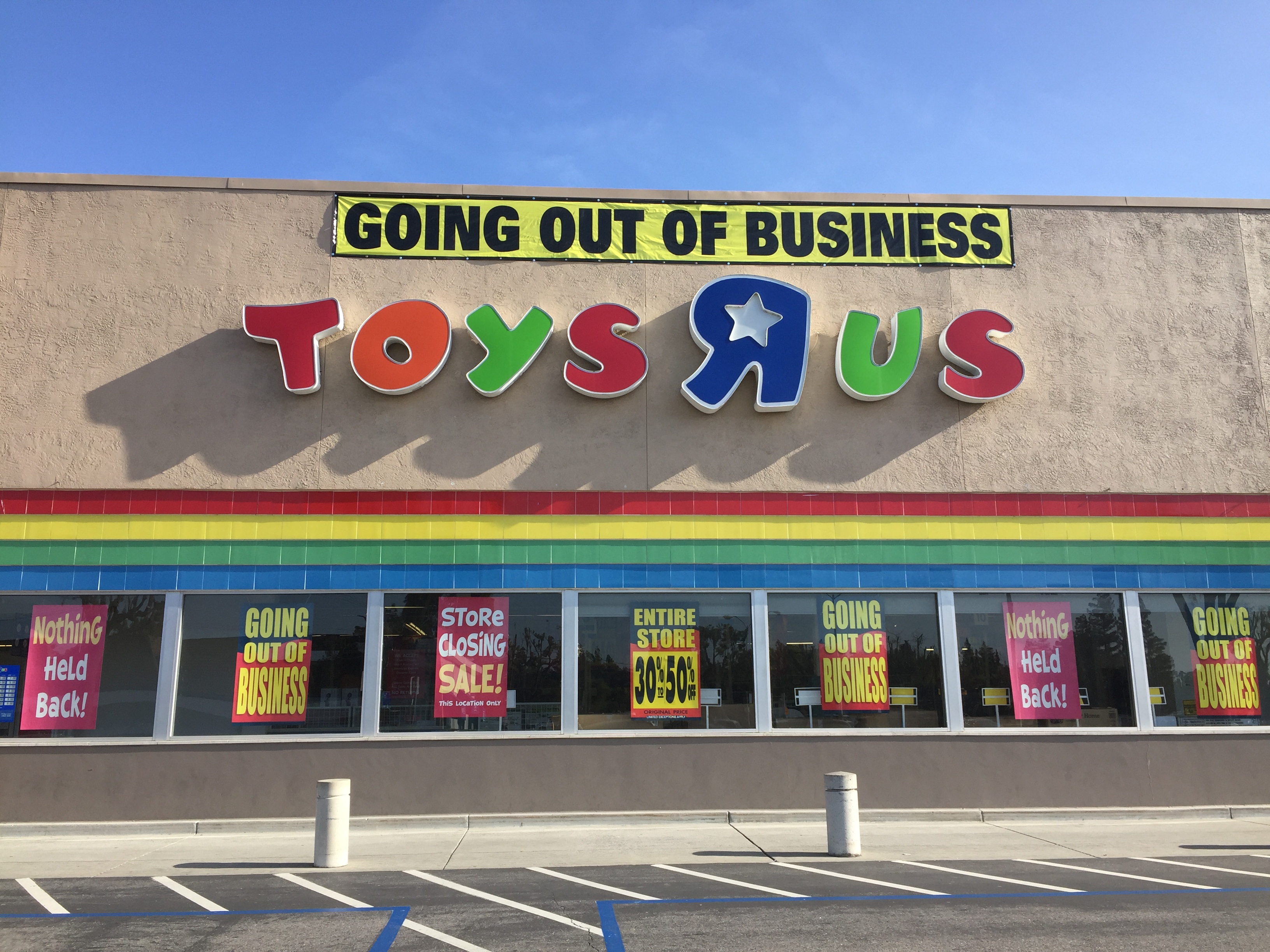
Yes, I remember the days of scrolling down the game aisles at Toys R Us once upon a moon. The iconic toy store is currently closing for good in 2018. Kind of sad to think my future kids will never know what it’s like to walk up and down those magical aisles. Rest In Peace, TRU.
WHAT THE CRITICS SAID
Ninja Gaiden Trilogy was met with mixed reviews. Some liked it for having all three classic NES platformers on one cartridge and the brand new password feature, but others did not like the cuts or mostly lazy effort. Even to this day, it remains quite the polarizing SNES title. EGM gave it scores of 8.5, 6.5, 6.5 and 6.0. Nowadays it fetches for a fair penny, so it’s hard to recommend it at the going rate unless you absolutely have to play a Ninja Gaiden game on your SNES.
CLOSING THOUGHTS
I liked Ninja Gaiden Trilogy when I first played it back in 2006. I still like it even though the project could have been handled better. Whereas Super Mario All-Stars knocked it out of the park, Ninja Gaiden Trilogy is not the poster boy for how to properly present a compilation. But the three NES games included in this package are still playable and at their core, they’re still quality games. I love the password feature as it allows me to beat the game at my pace, and also encourages random revisiting throughout the years. The critics can hate on this game all they like — I still enjoy it very much and come back to it every so often.
Although sadly not the Ninja Gaiden sequel we wanted or even the A+++ port we deserved, the games are still good enough to make this a redeeming package. Should it have been more? For sure. A Ninja Gaiden game on the SNES should be in the pantheon of Super Nintendo greats. This is far from that but in the end, I’m grateful to have it in my collection. And I’m not talking from a monetary stance. I still like playing these three games and always will. Sometimes we can get hung up on what isn’t rather than simply enjoying what is. In the case of Ninja Gaiden Trilogy — despite being slightly butchered — better to have it on the SNES than not at all.
Graphics: 5.5
Sound: 7.5
Gameplay: 7.5
Longevity: 6.5
